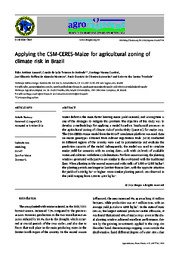Applying the CSM-CERES-Maize for agricultural zoning of climate risk in Brazil.
Applying the CSM-CERES-Maize for agricultural zoning of climate risk in Brazil.
Author(s): AMARAL, T. A.; ANDRADE, C. de L. T. de; CUADRA, S. V.; MONTEIRO, J. E. B. de A.; GUIMARAES, P. E. de O.; TRINDADE, R. dos S.
Summary: Water deficit is the main factor limiting maize yield in Brazil, and sowing time is one of the strategies to mitigate this problem. The objective of this study was to develop a methodology for applying a model based on biophysical processes in the agricultural zoning of climate risk of productivity (ZarcPro), for maize crop. The CSM-CERES-Maize model from the DSSAT simulation platform was used. Data on maize genotypes obtained from cultivar registration trials (VCU) conducted in different regions of the country were used to parameterize and evaluate the predictive capacity of the model. Subsequently, the model was used to simulate maize yield for scenarios with 36 sowing dates, soils with six levels of available water, and cultivars with three cycle durations. For first-season sowing, the planting windows generated with ZarcPro are similar to those obtained with the traditional Zarc. When planting in the second season and with yields of 1,000 or 2,000 kg ha-1, the planting periods are longer in ZarcPro than in Zarc, with the opposite situation for yields of 6,000 kg ha-1 or higher. More similar planting periods are observed in the yield ranging from 3,000 to 4,000 kg ha-1.
Publication year: 2024
Types of publication: Journal article
Unit: Embrapa Maize & Sorghum
Observation
Some of Embrapa's publications are published as ePub files. To read them, use or download one of the following free software options to your computer or mobile device. Android: Google Play Books; IOS: iBooks; Windows and Linux: Calibre.
Access other publications
Access the Agricultural Research Database (BDPA) to consult Embrapa's full library collection and records.
Visit Embrapa Bookstore to purchase books and other publications sold by Embrapa.

